China: the People's Republic
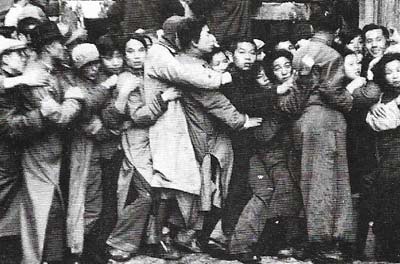
Figure 1. Lines outside banks in 1948 marked a collapse of confidence in China's currency and in the ability of the Nationalists to manage the economy. Inflation set off by the irresponsible issue of banknotes was a problem during the Japanese war and it accelerated between 1945 and 1948 when the Shanghai price index rose 135,742 times, causing a hyperinflation. This the Communist government inherited.
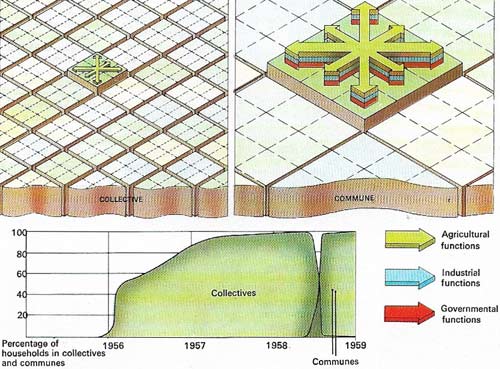
Figure 2. People's communes were introduced in the summer of 1958. This was to be the culmination of the socialist transformation of agriculture. In 1953-1954 peasant households had been organized into mutual aid teams. In 1955 these merged to form cooperatives which, in turn, were merged into collectives in 1956-1957. About eight times larger than the collectives, communes were also units of government coordinating planning in agriculture, industry, defense and education.
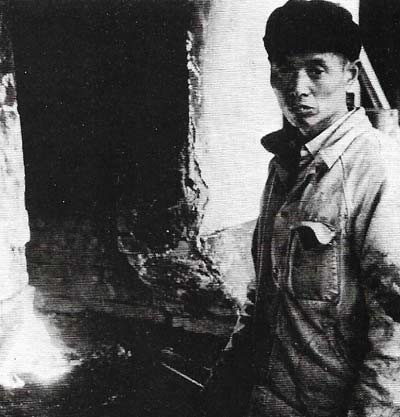
Figure 3. Backyard furnaces and foundries epitomized the Great Leap Forward, a drive launched in February 1958 to accelerate expansion of the Chinese economy. By mobilizing under-employed rural labor in small, labor-intensive industries it was intended to complement the production of urban-based, capital-intensive industries little extra cost to investment funds. Called "walking on two legs" this strategy of economic development was widely promoted.

Figure 4. During the Great Leap Forward agricultural and industrial output dropped. Inadequate planning and accounting lead to miscalculation of potential yields and failure to meet the targets set. Lack of experience and disorganization meant that many communes were ill-equipped and badly run. The worst weather for a century in 1959–1560 lead to economic crisis and the policies of the Great Leap Forward were shelved.
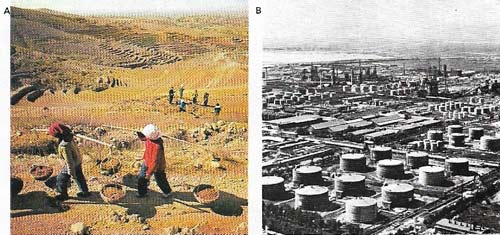
Figure 5. Exemplary production units singled out by Mao Tse-tung in 1964 were Tachai agricultural brigade in Hsiyang county, Shansi province, and the Taching oilfield in Heilungkiang province. In Tachai (A) peasants transformed a poor environment and increased grain output without state aids or material incentives. In Taching (B) workers created a prototype agro-industrial community developed without foreign aid by reliance on their own technological innovations. Both show the importance attached to self-reliance, hard work, and persistence in Chinese economic development after 1960. Then, as a result of frequent ideological differences, the Soviet Union withdrew her many technicians and cancelled all her aid program to the Chinese People's Republic.

Figure 6. The Little Red Book of quotations from Mao Tse-tung became the "bible" of the cultural revolution of 1966-1968. It was studied on a nationwide basis as a pocket guide for action in any set of circumstances. Bit it was put to most use in the hands of young people, particularly Red Guards recruited from middle schools, universities and factories. As "successors to the revolution", they formed a main force in the campaign by Mao Tse-tung and his supporters against Liu Shan-chi, then head of state, and aspects of traditional culture standing in the way of Maoist policies.
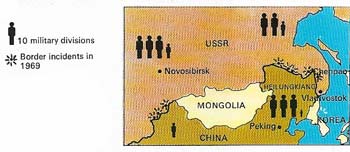
Figure 7. Border clashes between Chinese and Soviet forces and the Ussuri river frontier in Heilungkiang in March 1969 showed the extent to which Sino-Soviet relations had deteriorated in the course of ideological disputes of the late 1950s. After the worst fighting over Chenpao or Damansky island, China claimed that the Soviet Union had provoked more than 4,000 incidents.
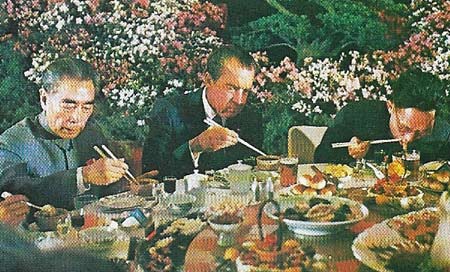
Figure 7. The visit of Richard Nixon, the US president, in 1972 marked a new era in China's foreign relations. Less hostile Sino-US attitudes had indirectly contributed to the admission of the People's Republic of China to the UN in 1971. It also led to better relations between China and Japan and increasing diplomatic isolation of the nationalist government of Chiang Kai-shek in Taiwan.
The Chinese People's Republic was established on 1 October 1949 by a mandate from a constituent assembly convened under the aegis of the Chinese Communist Party (CCP). The immediate task of the new government was to rehabilitate the war-ravaged economy inherited from Chiang Kai-shek's Nationalist administration after its forced withdrawal to the offshore province of Taiwan. A gradualist policy was adopted, characterized by the creation of a coalition of the various elements in Chinese society and the avoidance of violent class struggle. The communists did not baulk at suppressing their most intractable class enemies, but they were preoccupied with carrying out measures to ensure economic survival.
 |
| Mao Tse-tung, as Chairman of the Chinese Communist Party and chairman elect of the government, stood in Tien An Men Square in Peking to proclaim the establishment of the People's Republic of China on 1 October 1949. |
Major reforms of the 1950s
Mass support gave the new government the authority to take steps to conquer hyperinflation (Figure 1). Land reform affecting over 80 percent of the population was completed by early 1953. As a result the government gained control over surplus agricultural production; it also won the peasant backing it needed to weaken social institutions based on a kinship system dominated by elders. This made it easier to set up new communist institutions in place of the old system. Another major reform was the implementation of the 1950 Marriage Law which greatly improved the status of women.
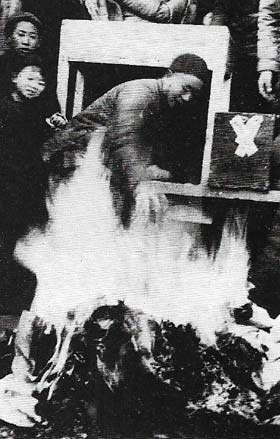 |
| Burning of land title deeds and the public condemnation of landlords were common during the nationwide land reform campaign conducted by the Chinese government between mid-1950 and early 1953. The political and social impact of this campaign was as important as its economic effect. Socially, the destruction of the old system was underlined by the public humiliation of landlords and venting of grievances by peasants led by communist cadres. Politically, the richer classes were isolated; economically, land redistribution among 300 million peasants stimulated their willingness to increase production. |
From 1953–1957 China underwent a transition to socialism as commerce and industry were nationalized and agricultural institutions transformed. These changes were not accomplished without dissent but, as a 1957 rectification campaign showed, the power of the enlarged party machine considerably exceeded that of its critics. Meanwhile in foreign affairs China was aligned with the USSR, whose aid was crucial to industrialization during the first five-year plan (1953–1957) and bitterly opposed to the United States, her major adversary in the Korean War (1950–1953), proponent of the policy of "containment" and supporter of Taiwan.
Hoping to expand production rapidly by amalgamating collective farms into communes (Figure 2) and by adopting a backyard approach to industrialization (4), China began the Great Leap Forward in 1958 marking the implementation of a Chinese strategy of economic development and the rejection of the Soviet strategy employed in the preceding five years. As a result, an ideological dispute between China and the USSR gathered momentum, leading to a withdrawal of Soviet technicians and their blueprints in 1960. In the event the Great Leap Forward failed, owing to dissent, bad weather and an underestimation of the problems (5). The outcome was an economic crisis and a forced retreat from Maoist principles.
The Cultural Revolution
The retreat was only temporary. Once economic recovery had been achieved in 1963 Mao Tse-tung (1893–1976), who had given up his post as head of state in 1959 to be replaced by Liu Shao-chi (1898–1974), resumed his efforts to realize socialism in China (Figure 5). By now the ideological split between the USSR and China was being reflected within the CCP and the specifically Maoist attempts at running the economy had been openly criticized. Mao Tse-tung countered by launching a campaign to reverse a deteriorating ideological situation and a weakening in his personal influence. The campaign, the Cultural Revolution, aimed on the one hand at purging the CCP and on the other at ridding China of aspects of traditional culture incompatible with socialism. Party members were ousted and the state structure usurped by revolutionary commit-tees in circumstances that sometimes led to violence. The key to Mao Tse-tung's success was his ability to mobilize support, especially from the young people, (Figure 6), coupled with the loyalty of the armed forces.
During the Cultural Revolution Mao Tse-tung presided over the rebuilding of the CCP and the mass organizations, a restoration of the state system, a restructuring of the education system and a reassessment of Chinese culture. The spilling over of the excesses of the Cultural Revolution into foreign affairs damaged China's international position for a while. Some 45 divisions of Soviet forces were deployed along the frontier, giving rise to armed clashes in 1969 (Figure 7). China's foreign relations now became marked by alignment with the Third World, friendship with the medium-sized developed countries, trade and diplomacy with Japan and the USA and continuing confrontation with the USSR.
Admission to the United Nations
The success of China's new foreign policy was characterized by her admission to UN membership in 1971 and by a visit by the American president, Richard Nixon (1913–1994), in 1972 (Figure 7). The eclipse of Lin Piao (1907–1971), the defence minister and Mao's heir apparent, who was reported killed during a flight to the USSR in 1971, suggests that an accommodation with capitalism at the expense of a reconciliation with the Soviet bloc was not unanimously approved. Nevertheless, China moved to the Fourth National People's Congress in January 1975 (the first for a decade), a new constitution and, for the first time since 1966, a fully manned state structure. Mao died in 1976 and was succeeded by Hua Kuo-feng. In the disturbances that followed, Mao's widow and some other prominent politicians were arrested and accused of treason.
